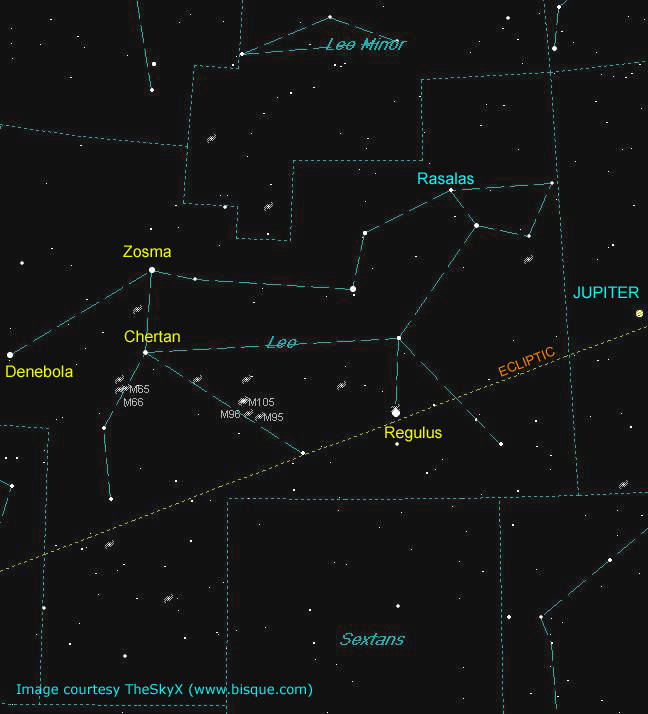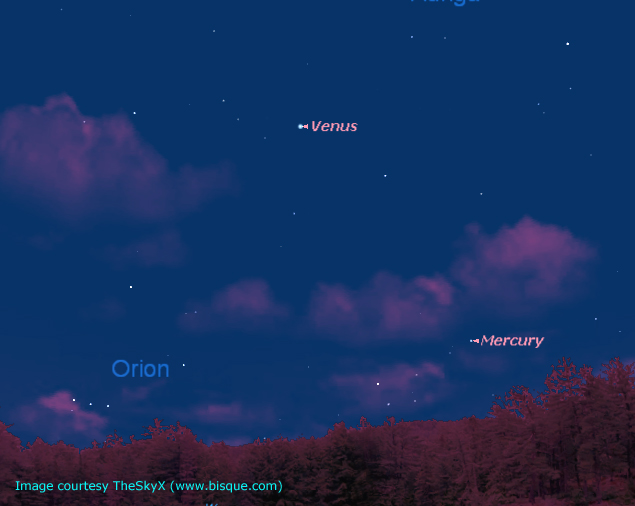Leo The Lion
About ten minutes after sunset, the planet Jupiter begins to reveal itself high overhead. This is a great time to investigate the planet’s belt and zones structure before the brightness of its cloud tops overwhelms the view. I first happened upon this technique back in 1994 when Comet SL-9 was impacting Jupiter. I saw amazing detail minutes after sunset but was harder to observe the fine stuff when the sky was black.
As always, be sure to check the Observer’s Handbook of the RASC page 233-234 for satellite times of moon and shadow transits such as May 21 and 27 when we will witness double shadow transits. As minutes tick by and more and more bright stars appear like popcorn in slow motion. This is my favourite time of the evening as one by one, distant suns reveal themselves.

When the sky eventually turns to night mode, look to the right of Jupiter for M44 - the Beehive Cluster. With a population of about 500 solar masses, this cluster rests 577 light-years away and is one of the closest clusters to us. Although its overall brightness is listed at magnitude 3.7, dark skies are needed to spot it naked eye. Looking east of Jupiter in the mighty lion named Leo to the left of Jupiter. Its alpha star is named Regulus and is 79 light-years from us. With a luminosity of 360 times that of our Sun, Regulus shines at magnitude 1.3. It is 4.3 times wider than our Sun and rotates at an astonishing 317 km/sec. As a result of this rapid spin, temperatures near the poles are 15,400 Kelvin compared to cooler equator’s 10,200 Kelvin. Regulus happens to be located on the ecliptic and from time to time is covered (occulted) by the Moon in its orbit around Earth.
The asterism that makes up the lion is first the backwards question mark starting from Regulus, thus forming the front half of the beast. Then to the east is the 30-60-90 triangle forming the hindquarters ending with the star called Denebola at 36 light-years away. Many fine galaxies dot Leo and into Virgo but the challenge is spotting the faint galaxy Leo 1. At on 850,000 light-years, this magnitude 11.2 smudge is only twenty arc minutes from blazing Regulus. The secret is to place This bright sun out of the field of view in the eyepiece.

Another favourite grouping to observe and photograph is called the Leo Triplet consisting of M65, M66 and NGC 3628 which reside 41, 33 and 25 million light-years from us respectively. All three consist of varying structure and is a must-see. Another great trio of galaxies can be located halfway between Regulus and the Triplet. These galaxies are M95, M96 and M105 and lie in the range of 33 to 35 million light-years away. But for those that love to galaxy surf, aim your scope about ten degrees east to a swarm of starry islands. Literally, hundreds towards Virgo and you will have your pick of the litter with an assortment of spirals and round elliptical galaxies.
Of the eight comets that are visible at some point in the night, Comet Lovejoy is still the brightest. It has not crossed over from Cassiopeia into Cepheus at around magnitude 7.5 and fading.
Mercury will be at its greatest elongation of 21 degrees from the Sun on May 7. On that date, it will be a bit more than 8 degrees NW of Aldebaran and will shine at magnitude 0.5. These two along with Venus will form a lovely triangle in the western sky – nice digital moment folks. And let’s not forget about the ringed planet Saturn that appears at the top of the scorpion’s claws. It is in opposition on the 23rd meaning it rises when the sun sets.

The annual Eta Aquarid meteor shower peaks at 13 hour UT or 9 am eastern on May 6. A by-product of Halley’s Comet, the Eta Aquarids are predominately a southern hemisphere shower that can produce up to 60 meteors per hour but only about 30 here in the north. To make things worse the near full Flower Moon from two nights earlier will reduce that number further again. New Moon occurs May 18 (lunation 1143).
Until next month, clear skies everyone.
Twitter: @astroeducator
